Tabarka
Tabarka (Arabic: طبرقة ![]()
Tabarka طبرقة | |
|---|---|
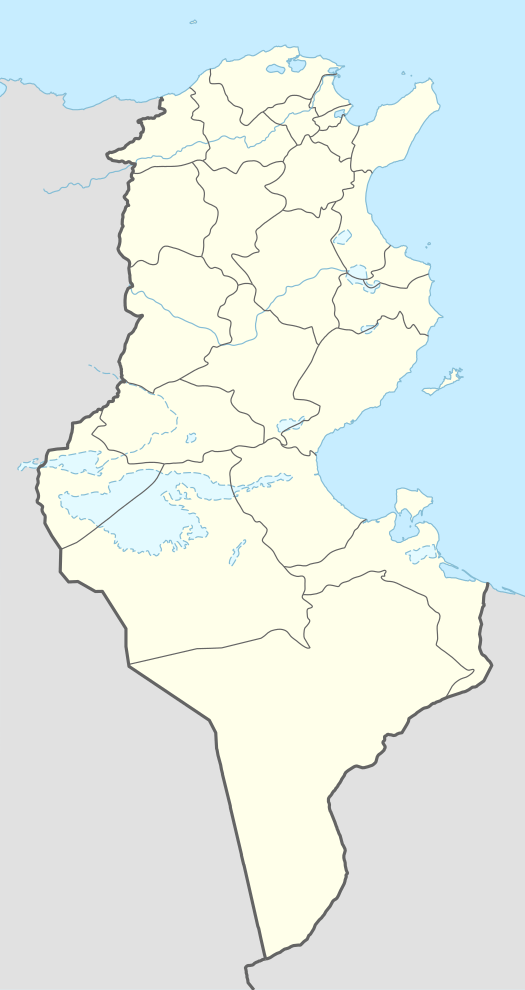 Tabarka Location in Tunisia | |
| Coordinates: 36°57′16″N 8°45′29″E | |
| Country | |
| Governorate | Jendouba Governorate |
| Elevation | 15.4 ft (4.7 m) |
| Population (2014) | |
| • City | 19,819 |
| • Density | 10,090/sq mi (3,894/km2) |
| • Urban | 41,293 |
| • Urban density | 80/sq mi (31/km2) |
| • Metro | 48.993 |
| • Metro density | 170/sq mi (64/km2) |
| Time zone | UTC1 (CET) |
| Postal Code | 8110 |
Name
Tabarka was known to the Carthaginians as TBRKʿN (Punic: 𐤕𐤁𐤓𐤊𐤏𐤍).[4][5] This was transcribed into Greek as Thaúbraka (Θαύβρακα) and Latin as Thabraca.[6][7] Modern day Berber knows it as Tabarka or Tbarga, and its Arabic name is Ṭbarqa (طبرقة).
History
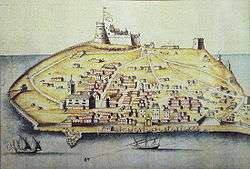
Although older sources placed Thabraca within the Roman province of Numidia, recent ones agree in placing it in the Roman province of Africa, known also as Africa Proconsularis.[8][9][10][11] It was a Roman colony.[12] It was connected by a road with Simitthu, which it served as a port for the export of its famous marble.[12] At Thabraca the rebellious Roman official Gildo, the brother of Firmus, committed suicide.[12] Under the Vandal king Gaiseric, it had a monastery for men and a convent for women.[12]
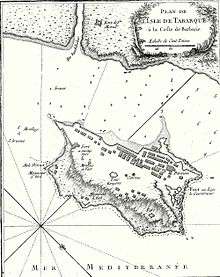
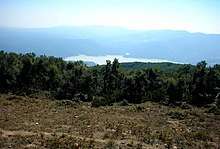
From 1540 to 1742, the Genoese maintained a garrison on the adjacent island, also called Tabarka, which lies about 365 yards (334 m) off the town. In 1540 the island was given by the Ottoman Bey of Tunis as a concession to the Genoese Lomellini family.[13] The Genoese were in the service of Spain during 1553 at the request of Emperor Charles V who was interested in coral fishing. The Lomellini were part of the circle of Andrea Doria, Doge of Genoa, and were related to the Grimaldi family. The grant was possibly due to a secret ransom for the release of the pirate Turkish Dragut, captured in 1540 by Giannettino Doria, nephew of Andrea Doria. The Lomellini colonized Tabarca with a group of inhabitants of Pegli,[14] near Genoa, where they had various properties and a huge palace. The community of Pegliesi lived in Tabarka for several centuries.
In 1738 due to the exhaustion of the coral reefs and the deterioration of relations with the Arab population a large group of "Tabarchini" moved to San Pietro Island off Sardinia, then uninhabited, where they founded a new town of Carloforte. The transfer was made possible thanks to the King of Sardinia, Charles Emmanuel III of Sardinia who wanted to colonize those of his lands which were not yet inhabited. The name of Carloforte was chosen in honor of the sovereign. Another group of Tabarchini was resettled in the town of Calasetta on the adjacent Island of Sant'Antioco, whose population still speaks a variant of Genoese dialect originating from Tabarka.[15] Others were moved to the Spanish island of New Tabarca.[16] In 1741 or 1742,[12] the Genoese fortress surrendered to the (nominally Ottoman but essentially autonomous) Bey of Tunis. At Tabarka, the ruins consists of a pit once used as a church and some fragments of walls which belonged to Christian buildings. There were also two Ottoman Turkish fortresses, one of which has been repaired.
.jpg)
Under French colonial rule it was annexed to the civil district of Souk el-Arba, now in the Tunisian governorate of Jendouba, and a rather important fishing centre. Tabarka Jazz Festival was established in 1973.
Ecclesiastical history
Thabraca became a Christian bishopric that is no longer a residential see but is included in the Catholic Church's list of titular sees.[11]
.jpg)
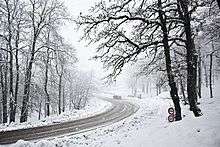
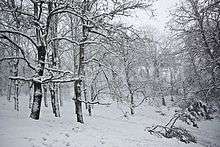
was also the seat of an ancient Bishopric and in antiquity it had a monastery for men and one for women,[12] and several church Buildings and Christian cemeteries have been uncovered.[17] The city contains several Christian cemeteries, many of the tombs covered with curious mosaics. An inscription (C.I.L., VIII, 173-82) mentions the cult of the martyr Anastasia and her companions.
Bishops
The bishops of Thabraca, who met with the other bishops of Proconsular Africa, included:
- Victoricus, at the Council of Carthage (256)[18]
- Rusticianus, at the conference of Carthage in 411, where his competitor was the Donatist Charentius; he also signed in 416 the letter from the council of Proconsular Africa to Pope Innocent I;
- Clarissimus, who in 646 signed the letter from the same Council to Patriarch Paul II of Constantinople against the Monothelites.
The Bishopric was founded during the Roman Empire and survived through the arian Vandal and Orthodox Byzantine empires, only ceasing to function with the Muslim conquest of the Maghreb. The diocese was re-founded in name at least in the 20th century as a titular see of the Roman Catholic church.[19][20]
Titular bishops
- Pierre Brigot, (22 Jan 1755 Appointed – 8 Nov 1791)
- St. Louis Gabriel Taurin Dufresse, (24 Jul 1798 Appointed – 14 Sep 1815)
- Edward Kernan (6 Feb 1818 Appointed – 19 Nov 1824)
- Rémi Gaulin † (10 May 1833 Appointed – 14 Jan 1840 Succeeded, Bishop of Kingston, Ontario)
- Bernardino di Milia, (27 Mar 1884 Appointed – 4 Jun 1891)
- Antonin Guillermain, (12 Jan 1895 Appointed – 14 Jul 1896)
- Henri Streicher, (1 Feb 1897 Appointed – 2 Jun 1933)
- Auguste-Joseph-Marie Cogneau (23 Jun 1933 Appointed – 12 Apr 1952)
- Georges Kettel, (24 Mar 1953 Appointed – 10 Nov 1959)
- Charles Quentin Bertram Olwell, (19 Jan 1961 Appointed – 30 Jan 1972)
- Antônio Agostinho Marochi (27 Sep 1973 Appointed – 2 Feb 1976)
- Sebastian Acol Dalis (18 Nov 1987 Appointed – 27 Oct 2004 Died)
- Pedro Joaquin Hernández Cantarero, (12 Feb 2005 Appointed – )[20]
Weather
Climate
The weather in Tabarka is usually unstable depending on the year. Summer is mostly mild and dry since it barely rains in July and August. The average temperatures for this season is 28.2 °C (82.8 °F). As for winter, it is mostly rainy and cold. Some snow can be seen during this time of the year. The average temperature for this season is 7.4 °C (45.3 °F).
| Climate data for Tabarka (1981–2010, extremes 1953–2017) | |||||||||||||
|---|---|---|---|---|---|---|---|---|---|---|---|---|---|
| Month | Jan | Feb | Mar | Apr | May | Jun | Jul | Aug | Sep | Oct | Nov | Dec | Year |
| Record high °C (°F) | 26.1 (79.0) |
29.2 (84.6) |
36.5 (97.7) |
37.0 (98.6) |
41.4 (106.5) |
47.1 (116.8) |
47.4 (117.3) |
48.4 (119.1) |
43.3 (109.9) |
39.7 (103.5) |
33.2 (91.8) |
28.1 (82.6) |
48.4 (119.1) |
| Average high °C (°F) | 15.7 (60.3) |
16.1 (61.0) |
18.2 (64.8) |
20.7 (69.3) |
24.8 (76.6) |
28.7 (83.7) |
31.7 (89.1) |
32.1 (89.8) |
29.3 (84.7) |
25.9 (78.6) |
20.6 (69.1) |
17.0 (62.6) |
23.4 (74.1) |
| Daily mean °C (°F) | 11.5 (52.7) |
11.8 (53.2) |
13.6 (56.5) |
15.8 (60.4) |
19.5 (67.1) |
23.0 (73.4) |
25.8 (78.4) |
26.6 (79.9) |
23.9 (75.0) |
20.7 (69.3) |
16.0 (60.8) |
12.8 (55.0) |
18.4 (65.1) |
| Average low °C (°F) | 7.6 (45.7) |
7.6 (45.7) |
8.9 (48.0) |
10.9 (51.6) |
14.0 (57.2) |
17.1 (62.8) |
19.9 (67.8) |
20.6 (69.1) |
18.8 (65.8) |
15.8 (60.4) |
11.9 (53.4) |
8.9 (48.0) |
13.5 (56.3) |
| Record low °C (°F) | −0.5 (31.1) |
−2.4 (27.7) |
0.2 (32.4) |
−1.4 (29.5) |
3.0 (37.4) |
7.5 (45.5) |
8.5 (47.3) |
9.0 (48.2) |
8.5 (47.3) |
4.0 (39.2) |
0.5 (32.9) |
0.0 (32.0) |
−2.4 (27.7) |
| Average precipitation mm (inches) | 140.4 (5.53) |
104.4 (4.11) |
88.1 (3.47) |
71.8 (2.83) |
40.7 (1.60) |
15.4 (0.61) |
3.2 (0.13) |
9.0 (0.35) |
65.0 (2.56) |
92.9 (3.66) |
154.2 (6.07) |
175.1 (6.89) |
960.2 (37.81) |
| Average precipitation days (≥ 1.0 mm) | 11.9 | 10.6 | 9.8 | 8.8 | 5.3 | 2.1 | 0.7 | 1.7 | 5.1 | 8.5 | 11.5 | 11.3 | 87.3 |
| Average relative humidity (%) | 72 | 73 | 73 | 72 | 72 | 70 | 65 | 68 | 70 | 71 | 75 | 74 | 71 |
| Mean monthly sunshine hours | 120.9 | 134.4 | 179.8 | 210.0 | 241.8 | 282.0 | 316.2 | 297.6 | 240.0 | 201.5 | 126.0 | 117.8 | 2,468 |
| Source: Institut National de la Météorologie (precipitation days/humidity/sun 1961–1990)[21][22][23][note 1] | |||||||||||||
| Jan | Feb | Mar | Apr | May | Jun | Jul | Aug | Sep | Oct | Nov | Dec |
|---|---|---|---|---|---|---|---|---|---|---|---|
| 16 °C (61 °F) | 15 °C (59 °F) | 15 °C (59 °F) | 16 °C (61 °F) | 18 °C (64 °F) | 21 °C (70 °F) | 24 °C (75 °F) | 26 °C (79 °F) | 25 °C (77 °F) | 23 °C (73 °F) | 20 °C (68 °F) | 17 °C (63 °F) |
Transport
The airport in Tabarka was named Airport 7 Novembre until the Tunisian revolution; it was then renamed Tabarka-Ain Draham International Airport.
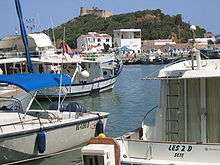
See also
References
Citations
- Derek Hopwood & Sue Mi Terry, Habib Bourguiba of Tunisia:The Tragedy of Longevity, Springer 2016 p.72
- Elżbieta Lisowscy, DK Eyewitness Travel Guide: Tunisia, Dorling Kindersley 2011 p.41
- Donna Wheeler, Paul Clammer & Emilie Filou, Tunisia: Lonely Planet, 2010 p.284
- Head & al. (1911), p. 886.
- Ghaki (2015), p. 67.
- "Charlton T. Lewis, Charles Short, A Latin Dictionary". Archived from the original on 28 February 2014. Retrieved 28 March 2016.
- Chapot, V. (1928). The Roman World. Knopf. p. 385. ISBN 9780819603678. Retrieved 28 March 2016.
- Hornblower, S.; Spawforth, A.; Eidinow, E. (2012). The Oxford Classical Dictionary. OUP Oxford. p. 33. ISBN 9780199545568. Retrieved 28 March 2016.
- Conant, J. (2012). Staying Roman: Conquest and Identity in Africa and the Mediterranean, 439-700. Cambridge University Press. p. 48. ISBN 9780521196970. Retrieved 28 March 2016.
- Saint Augustine; Rotelle, J.E.; Teske, R.J. (2001). Letters 1-99. New City Press. p. 264. ISBN 9781565481633. Retrieved 28 March 2016.
- Annuario Pontificio 2013 (Libreria Editrice Vaticana, 2013, ISBN 978-88-209-9070-1), p. 979
- Thabraca at Catholic Encyclopedia.org
- Thomas Allison Kirk, Genoa and the Sea, JHU Press, 2013
- http://www.lastampa.it/2012/05/01/societa/viaggi/home-cover/l-isola-di-tabarka-e-le-tracce-dei-genovesi-I4Wnl6mzUmuPSygQXZ3h7J/pagina.html accessed 4/2/2017
- http://www.sardegnaturismo.it/en/point-of-interest/calasetta accessed 4/2/2017
- Varela, Santiago (1983). "Nueva Tabarca / Nova Tabarca: 1. Generalidades / 1. Generalitats". Alicante / Alacant, Tabarca: Rutas de aproximación al patrimonio cultural valenciano / Rutes d'aproximació al patrimoni cultural valencià (in Spanish and Catalan). Juan Calduch; Joaquín Lara (graphic dessing). Servicio de patrimonio arquitectónico: Conselleria de Cultura, Educación y Ciencia: Generalidad Valenciana.
- Thabraca at New Advent Catholic Encyclopedia.
- A Library of Fathers of the Holy Catholic Church, Anterior to the Division of the East and West, Volume 17 (J.H. Parker, 1844) p294.
- Titular Episcopal See of Thabraca at GCatholic.org.
- Thabraca at catholic-hierarchy.org.
- "Les normales climatiques en Tunisie entre 1981 2010" (in French). Ministère du Transport. Archived from the original on 19 December 2019. Retrieved 3 January 2020.
- "Données normales climatiques 1961-1990" (in French). Ministère du Transport. Archived from the original on 21 December 2019. Retrieved 3 January 2020.
- "Les extrêmes climatiques en Tunisie" (in French). Ministère du Transport. Archived from the original on 21 December 2019. Retrieved 3 January 2020.
- "Réseau des stations météorologiques synoptiques de la Tunisie" (in French). Ministère du Transport. Retrieved 3 January 2020.
- Weather2Travel - Tabarka. Retrieved 2 July 2020.
Notes
- The Station ID for Tabarka is 22525211.[24]
Bibliography
- Herbermann, Charles, ed. (1913). . Catholic Encyclopedia. New York: Robert Appleton Company.
- Ghaki, Mansour (2015), "Toponymie et Onomastique Libyques: L'Apport de l'Écriture Punique/Néopunique" (PDF), La Lingua nella Vita e la Vita della Lingua: Itinerari e Percorsi degli Studi Berberi, Studi Africanistici: Quaderni di Studi Berberi e Libico-Berberi, No. 4, Naples: Unior, pp. 65–71, ISBN 978-88-6719-125-3, ISSN 2283-5636. (in French)
- Head, Barclay; et al. (1911), "Numidia", Historia Numorum (2nd ed.), Oxford: Clarendon Press, pp. 884–887.
External links
| Wikimedia Commons has media related to Tabarka. |
- Tabarka.Com Tabarka Guide
- Tabarka.Org
- Photo gallery of Tabarka in 1924. French Naval Intelligence
- WorldStatesmen-Tunisia
- Reading Room Manchester. "CWGC – Cemetery Details". cwgc.org. Retrieved 28 March 2016.
